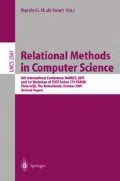Abstract
Groups are one of the most fundamental notions in mathematics. This paper provides a foundation of group theory in allegories. Almost all results in the paper can be applied to theory of fuzzy groups.
Access this chapter
Tax calculation will be finalised at checkout
Purchases are for personal use only
Preview
Unable to display preview. Download preview PDF.
References
C. Brink, W. Kahl and G. Schmidt (eds.), Relational methods in computer science. Advances in Computing Science, (Springer, Wien, New York, 1997).
S. Curtis and G. Lowe, A graphical calculus, Lecture Notes in Computer Science 947 (1995), 214–231.
D. Dougherty and C. Gutiérrez, Normal forms and reduction for theories of binary relations, Lecture Notes in Computer Science, 1833(2000), 95–109.
P. Freyd and A. Scedrov, Categories, allegories (North-Holland, Amsterdam, 1990).
J. Desharnais, Monomorphic characterization of n-ary direct products, Information Sciences 119(1999), 275–288.
W. Kahl and G. Schmidt, Exploring (finite) relation algebras using tools written in Haskell, Technical Report 2000-02, Fakultät für Informatik, Universität der Bundeswehr München, October 2000.
Y. Kawahara, Relational set theory, Lecture Notes in Computer Science, 953(1995), 44–58.
Y. Kawahara, Lattices in Dedekind categories, In: Orlowska, E. and Szalas, A. (Eds), Relational Methods for Computer Science Applications, Physica-Verlag, 2001, 247–260.
S. Mac Lane, Categories for the working mathematician, (Springer-Verlag, 1972).
R. Maddux, On the derivation of identities invloving projection functions, Logic Colloquium’ 92, ed. Csirmaz, Gabbay, de Rijke, Center for the Study of Language and Information Publications, Stanford, 1995, 145–163.
G. Schmidt and T. Ströhlein, Relations and graphs — Discrete Mathematics for Computer Scientists — (Springer-Verlag, 1993).
A. Rosenfeld, Fuzzy groups, J. Math. Anal. Appl. 35(1971), 512–517.
Author information
Authors and Affiliations
Editor information
Editors and Affiliations
Rights and permissions
Copyright information
© 2002 Springer-Verlag Berlin Heidelberg
About this paper
Cite this paper
Kawahara, Y. (2002). Groups in Allegories. In: de Swart, H.C.M. (eds) Relational Methods in Computer Science. RelMiCS 2001. Lecture Notes in Computer Science, vol 2561. Springer, Berlin, Heidelberg. https://doi.org/10.1007/3-540-36280-0_7
Download citation
DOI: https://doi.org/10.1007/3-540-36280-0_7
Published:
Publisher Name: Springer, Berlin, Heidelberg
Print ISBN: 978-3-540-00315-1
Online ISBN: 978-3-540-36280-7
eBook Packages: Springer Book Archive

